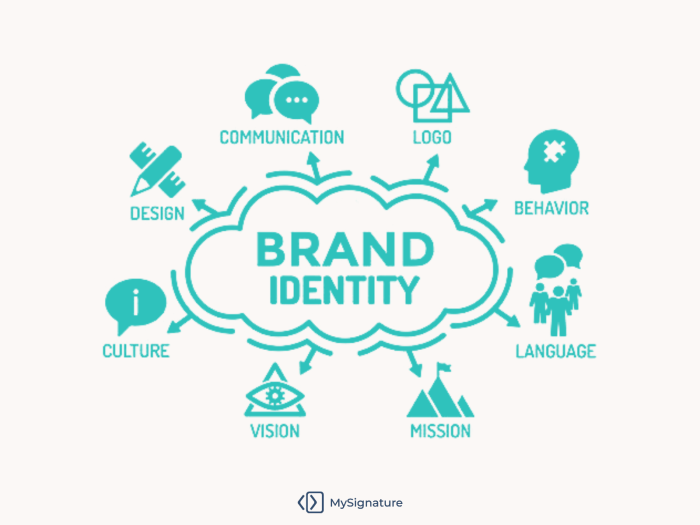Creating a Personal Branding Strategy sets the stage for defining who you are in the digital world, guiding you towards unlocking your unique identity and making a lasting impact.
Embark on a journey of self-discovery as we delve into the art of personal branding and how it can shape your future success.
Understanding Personal Branding
Personal branding is the practice of marketing yourself as a brand. It involves creating a unique identity and image for yourself that sets you apart from others. This can include showcasing your skills, expertise, and personality to attract opportunities and build a strong reputation.
Successful Personal Branding Strategies
- Consistent and Authentic Messaging: Ensure that your personal brand message is consistent across all platforms and authentic to who you are.
- Engagement and Interaction: Engage with your audience regularly through social media, networking events, and other channels to build relationships.
- Showcasing Expertise: Demonstrate your expertise in your field by sharing valuable content, participating in industry discussions, and showcasing your work.
- Visual Identity: Create a strong visual identity through your website, social media profiles, and other marketing materials to make a memorable impression.
Importance of Personal Branding in Today’s Digital Age
In today’s digital age, personal branding is more important than ever. With the rise of social media and online platforms, individuals have the opportunity to reach a global audience and make a lasting impact. Personal branding can help you stand out in a competitive job market, attract clients or customers to your business, and build a strong network of contacts. It also allows you to control the narrative of your story and build credibility in your field.
Identifying Your Target Audience
Identifying and defining your target audience is crucial in creating a successful personal branding strategy. Your target audience consists of the specific group of people who are most likely to be interested in what you have to offer.
Tips for Identifying Your Target Audience
- Conduct market research to understand the demographics, interests, and behavior of your potential audience.
- Utilize surveys, social media insights, and website analytics to gather data on your audience.
- Consider the problems and needs of your target audience that your personal brand can address.
Aligning Your Personal Brand with Your Audience
It is essential to align your personal brand with the needs and preferences of your target audience to create a strong connection and build trust.
By understanding and catering to the desires and expectations of your audience, you can tailor your personal brand messaging and content to resonate with them effectively.
Defining Your Unique Value Proposition
In the world of personal branding, your unique value proposition is what sets you apart from others and showcases what makes you special. It’s essentially your personal brand promise to your audience, highlighting the unique benefits and value you can offer.
Strategies for Defining and Communicating Your Unique Value Proposition
- Identify your strengths and skills: Take some time to reflect on what you excel at and what makes you unique. This can help you pinpoint your key value proposition.
- Understand your target audience: Knowing who you are trying to reach can help you tailor your value proposition to meet their specific needs and desires.
- Create a clear and concise statement: Craft a succinct message that clearly communicates what you offer and why it matters to your audience.
- Showcase your value through branding elements: Use your personal branding elements such as your logo, colors, and messaging to reinforce your value proposition consistently.
How a Strong Value Proposition Can Set You Apart from Competitors
A strong value proposition can differentiate you from your competitors by highlighting what makes you unique and why you are the best choice for your audience. It helps you stand out in a crowded marketplace and attract the right opportunities that align with your personal brand.
Creating a Consistent Brand Image
Consistency in branding is crucial as it helps to establish trust and recognition among your audience. A cohesive brand image ensures that your message is clear and easily identifiable across different platforms, making it easier for customers to connect with your brand.
Tips for Creating a Cohesive Brand Image
- Use the same color palette: Consistency in colors helps in creating a strong visual identity for your brand. Choose a color scheme that aligns with your brand values and use it consistently across all platforms.
- Develop a brand voice: Define the tone and style of communication that reflects your brand personality. Whether it’s casual and friendly or formal and professional, maintaining a consistent voice helps in building brand recognition.
- Design a logo and stick to it: Your logo is often the first thing people notice about your brand. Ensure that it is well-designed, memorable, and used consistently across all marketing materials.
- Create brand guidelines: Establish clear brand guidelines that Artikel how your brand should be represented visually and verbally. This includes rules for logo usage, color schemes, typography, and messaging.
- Engage with your audience: Interact with your audience in a consistent manner across social media platforms and other communication channels. Respond to comments and messages promptly and in line with your brand voice.
Elements Contributing to a Consistent Brand Image
- Typography: Consistent use of fonts and typography styles helps in reinforcing your brand identity and maintaining a professional look across all platforms.
- Imagery: Use consistent imagery that aligns with your brand values and resonates with your target audience. Whether it’s photographs, illustrations, or graphics, ensure they are cohesive and reflect your brand essence.
- Messaging: Craft messaging that is in line with your brand values and resonates with your target audience. Consistent messaging helps in reinforcing brand identity and building brand loyalty.
- Website Design: Ensure that your website design reflects your brand image and values. Consistency in layout, color scheme, and overall design elements helps in creating a seamless brand experience for visitors.
Developing a Content Strategy: Creating A Personal Branding Strategy
In the realm of personal branding, content plays a crucial role in shaping how others perceive you and your brand. It is the vehicle through which you communicate your values, expertise, and personality to your audience.
Creating Engaging and Relevant Content
When creating content for your personal brand, it is essential to keep your target audience in mind. Here are some strategies to help you develop engaging and relevant content:
- Research your audience: Understand their interests, pain points, and preferences to tailor your content accordingly.
- Provide value: Offer useful information, insights, or entertainment to keep your audience engaged.
- Be authentic: Stay true to yourself and your brand voice to build trust with your audience.
- Use multimedia: Incorporate a variety of content formats such as videos, infographics, and blog posts to cater to different preferences.
The Importance of Storytelling, Creating a Personal Branding Strategy
Storytelling is a powerful tool in personal branding as it helps create an emotional connection with your audience and makes your brand more relatable. Here’s why storytelling is crucial:
- Humanizes your brand: Stories make your brand more human and help people connect with you on a deeper level.
- Memorable impact: People remember stories better than facts or statistics, making your brand stand out.
- Showcases your values: Through storytelling, you can communicate your values and beliefs in a compelling way.
Leveraging Social Media

Social media plays a crucial role in personal branding as it allows individuals to connect with a wider audience, showcase their expertise, and build credibility in their niche. It provides a platform to share valuable content, engage with followers, and establish a strong online presence.
Choosing the Right Social Media Platforms
- Identify your target audience: Determine where your audience spends their time online and choose platforms that align with their preferences.
- Consider your content format: Select social media platforms that support the type of content you create, whether it’s visuals, videos, or written posts.
- Evaluate platform demographics: Research the demographics of different social media platforms to ensure that your target audience is active on those channels.
- Focus on platform engagement: Look for platforms where you can easily engage with your audience through comments, likes, shares, and direct messages.
Effectively Engaging with Your Audience on Social Media
- Respond to comments and messages promptly to show that you value your audience’s feedback and engagement.
- Create interactive content such as polls, quizzes, and Q&A sessions to encourage participation and conversation.
- Showcase behind-the-scenes content to give your audience a glimpse into your personal and professional life, building a more authentic connection.
- Collaborate with influencers or other brands in your industry to expand your reach and credibility among your target audience.
Building Relationships and Networks

Building relationships and networks is crucial in personal branding. It helps you connect with your audience, industry peers, and potential collaborators, ultimately expanding your reach and opening up new opportunities.
Strategies for Building Meaningful Relationships
- Engage authentically: Interact with your audience and peers genuinely, showing your personality and values.
- Offer value: Provide valuable content, insights, or support to your network to build trust and credibility.
- Attend industry events: Participate in conferences, workshops, and networking events to meet new people and strengthen relationships.
- Follow up: Don’t forget to follow up with contacts after initial meetings to maintain connections and continue building relationships.
Expanding Reach and Opportunities through Networking
- Collaborations: Networking can lead to collaborations with other brands or influencers, expanding your reach to new audiences.
- Job opportunities: Building a strong network can open doors to new career opportunities and collaborations within your industry.
- Mentorship: Networking with experienced professionals can provide mentorship opportunities, guidance, and career advice.
